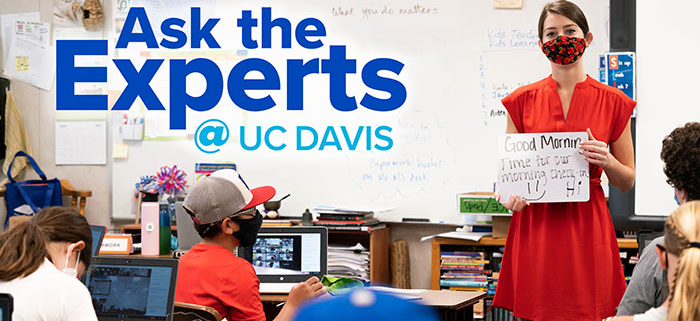Education Experts Break Down the Lingering Impacts and Unexpected Outcomes of COVID-19 Pandemic
By Maddy Gorrell
The COVID-19 pandemic highlighted the vital role school systems play in daily life, from learning and socialization to nutrition programs, transportation, and mental health. In the absence of in-person instruction, countless new stressors impacted families, teachers, and administrators who were working to maintain consistency for students.
Five years out from the start of the pandemic, the impacts can still be felt throughout the education field. As of 2024, California students are half a year behind their 2019 predecessors, remaining 31% of a grade equivalent below pre-pandemic levels. New teachers are also entering the field at significantly lower rates and veteran teachers are retiring earlier in their careers.
Despite these persistent challenges, the pandemic also revealed new pathways to success for schools. There are opportunities to increase access to learning technologies, collaborate more closely with parents to reduce chronic absenteeism, and even uplift students’ and teachers’ voices in transformative education policies.
To help break down the lasting effects of the pandemic on education and how we can address them, we reached out to five experts from the UC Davis School of Education to learn more:
- Michal Kurlaender, professor
- Margarita Jimenez-Silva, professor
- Kevin Gee, professor
- Alexandria Hurtt, Ph.D. ‘21 and research fellow
- Garth Lewis, Ed.D. ‘25 and Yolo County Superintendent of Schools

How has student success fared from the beginning of the pandemic to now?
Michal Kurlaender: As of last spring, students were still roughly half a year behind where their predecessors were in 2019. There has been some recovery, but not as fast as we would like. An important part of this story is that the impacts of COVID-19 have been extremely uneven—learning loss has been exacerbated by class, racial, and ethnic inequalities. Lower-income students today are further behind upper-income students than they were five years ago. Black and Latinx students are also further behind Asian and white students than they were pre-pandemic, and those inequalities were already large to begin with.
What are some of the unexpected ways that COVID-19 disrupted students’ learning?
Kevin Gee: An early warning signal that students are disengaging with our education system, especially in the elementary years, is chronic absenteeism—which is defined as missing 10% or more of the school year. From 2021 and 2022, there was a large increase in chronic absenteeism among California students, tripling to 30% of missed days. Since 2022, there has been a downward trend of 10%, but chronic absenteeism is still sitting at 20%: more than double what it was before COVID-19. It’s important we talk about the increased number of days that K-12 students have missed and continue to miss because chronic absenteeism impacts so much of their development, from their academic achievements and social-emotional learning to longer-term outcomes like dropping out of school or enrolling in college.
Garth Lewis: Chronic absenteeism—and attending virtual class—also impacted students’ mental health. Their sense of self, belonging, and connection in the classroom were drastically impacted by social isolation caused by the pandemic. In a 2020 survey conducted by Yolo County, 36% of all students reported experiencing chronic sadness or hopelessness while at school. This reality persists at the national level and years after the pandemic. According to the Center for Disease Control, among high school students in 2023, 40% reported persistent feelings of sadness or hopelessness in the past year, and 20% of adolescents ages 12-17 reported having unmet mental health care needs.
Michal Kurlaender: The pandemic also affected how high school students are thinking about their academic and financial futures. We surveyed Class of 2020 high schoolers, and they shared their trepidations about going to college. One response said “I’m concerned about being unable to pay rent or other educational expenses. The pandemic has added a lot of stress that’s distracting me from my academic goals.” We asked students about these kinds of stressors related to COVID-19, and 82% were concerned about taking online classes, 73% were concerned about their personal financial situation, and 71% were concerned about their families experiencing financial hardships.
Were these challenges measured across all student demographics?
Kevin Gee: There were disparities in chronic absenteeism rates by race and ethnicity. California overall has not yet gone back to pre-pandemic levels, and more disturbingly and challenging is that these disparities are within racial and ethnic subgroups. Some groups have rates that continue to be twice as high, and I do want to point out that Asian-American students tend not to get a lot of attention on this, but their rates are almost triple the rate that they were pre-pandemic. I do want to dispel some myths related to chronic absenteeism. Oftentimes, people will say, “Kids don’t care about school because parents don’t care.” This is very rare. Kids are not showing up to school because of push and pull factors that are often tied to structural determinants like transportation, housing, or health that can impact a family’s ability to get their kids to school.
Michal Kurlaender: College enrollment was already declining in California and across the country before the pandemic. But COVID-19 greatly contributed to this decline and led to larger rates overall. Community college enrollment dropped between 13 and 14%, CSU enrollment dropped by about 5.4%, and private or out-of-state institution enrollment dropped by 3.2%. Overall, there were steeper declines for racial and socioeconomic groups. Surprisingly, the UC system saw an increase in enrollment for the class of 2020, largely because there was an increase of in-state applications, many from higher-income families, and a reduction of out-of-state and international applications.
What were some of the early successes schools had while responding to the COVID-19 pandemic?
Alexandria Hurtt: California educational agencies were tasked with creating learning continuity and attendance plans for all students. Their first priority was ensuring that students got the education they should, even though they weren’t attending school every day. The second supported students’ progress by evaluating the methods schools had been using to assess students in math, Language Arts, and English language development. The third priority was to address any tensions on learning—how the pandemic was impacting students outside of the classroom in terms of their physical, mental, social, and emotional health.
A major success was that we saw a lot of districts really focused on making more devices available to students, increasing access to Wi-Fi and hotspots, and just helping students receive more support in their progress and assessments. We also saw a focus on better understanding students’ learning development in math and Language Arts, as well as English language development. There was also a focus on science, which wasn’t necessarily a priority, but school districts wanted to create more opportunities for hands-on activities, especially since students weren’t in the classroom.
There was also a big push to support students’ well-being, which included more lessons on mental health, bringing in more counselors, and trying to really build a supportive classroom environment. Even though students weren’t in class and couldn’t interact with their teachers in person, the schools created plans for teachers to have more one-on-one conversations, especially for students that needed additional support, such as students with disabilities and English language learners.
How did demands on teachers evolve and what were the results?
Margarita Jimenez-Silva: We saw equity gaps widen among teachers. Schools went from asking teachers to teach online from their homes to requiring them to travel to a school site and teach online from an empty classroom. Transportation became an access issue for a lot of these teachers, because they had previously relied on carpooling or public transportation to get to school, and now needed to figure out how they were going to get there without these resources available.
During the pandemic, there was also a significant increase in the number of teachers who were resigning within the first three years of teaching. Traditionally, the field has tracked teachers within the first five years, but we saw significant increases in the number of teachers who weren’t even making it to year three. Veteran teachers were also retiring a lot earlier, impacting high needs areas like English language learning.
At UC Davis, we’ve been working to better understand what encourages a teacher to leave or stay in the profession, partnering with and conducting research with teachers. Our team interviewed novice teachers, 92% of whom were people of color, who had submitted paperwork to leave teaching and then changed their minds. We were curious to learn what encouraged them to stay, and they revealed that a lot of it had to do with a commitment to their community. Our second study addressed veteran teachers—educators who have been teaching for over 22 years. We asked them why they stayed in the profession, how they navigated the pandemic, and why they didn’t retire. We learned a lot from their perspectives, particularly in relation to social-emotional learning. As a field, we are not offering enough social-emotional learning and support for teachers. They will talk about how they’re expected to teach it, but the same affordances they’re supposed to give students are not given to them as a professional.
What interventions have been most effective at closing lingering gaps in schools that resulted from COVID?
Garth Lewis: In my district, we created a system for delivering mental health services to students through their schools. We relied on a significant partnership between the K-12 schools and local social services—primarily Yolo County Health and Human Services and a cadre of community-based organizers who were already providing mental health services—to make this system happen. As a result, 92% of students in our program self-reported that they were satisfied or very satisfied with the services.
Kevin Gee: One of my colleagues looked at the top-motivational factors for kids to attend class. They interviewed chronically absent students who were missing large amounts of school, and 81% of those kids said they want to come because of the people and their relationships. This says a lot about potential solutions to chronic absenteeism. I conducted research with Attendance Works and the California Collaborative for Educational Excellence, and we did a deep dive into districts that had prominently lower chronic absence rates post-pandemic. The success story centers around trust and engagement: these schools built trust with and engaged parents. They also had strong social-emotional learning components and clear health guidance.
Alexandria Hurtt: A bright spot from the pandemic is that COVID-19 exposed a lot of inequities already present in education, specifically regarding technology and access. One intervention that’s carried over is the infrastructure to put more computers in schools and increase the availability of Wi-Fi and hot spots to support students’ learning. We’ve also seen permanent, positive changes to plans for student meals, and overall, schools are really focusing on addressing students’ needs first. These interventions might not have become so widespread had the pandemic not happened.
Michal Kurlaender: The pandemic helped the world realize how much happens at schools and how necessary they are for our broader societal health. There has been a lot of innovation, agility, and flexibility that came about because of COVID-19, but I think we still don’t always know what works. I caution us to think about who really benefits from new interventions—who can take advantage of new pathways and new systems. I worry a lot about our community college students, many of whom we hope will come to the University of California. They’re facing a very different higher education system today than they would have six years ago. Even the value proposition has changed. All of this worries me at a time when we’re seeing statistics that really show widening inequalities across many groups.
I find optimism in the fact that schools’ pandemic recovery strategies have really brought in a variety of innovations for schooling environments. Today, there is so much richer diversity in learning options for higher education and K-12 students. We should celebrate this because even universities are doing things they never would have agreed to do before, like teaching hundreds of students online.
The COVID-19 pandemic posed new challenges to every level of the education field. As policymakers begin to address its long-term effects, what are some areas that they should prioritize in their work?
Garth Lewis: California has made all kinds of one-time investments in education since the start of the pandemic. These funds are often distributed in a piecemeal fashion from different agencies, and schools are required to develop an implementation plan for each investment. The state needs to understand that it’s nearly impossible for them to hold school districts accountable for producing reports and plans that demonstrate how the investments were used. We need more space and time for implementation and more flexibility and local control.
I’ll also say that policy implementation often recommends or requires cross-sector collaboration, but the coordination of those efforts goes largely unfunded and unrecognized. Someone is responsible for convening stakeholders and following up between meetings to ensure the work is getting done, but that person often must do extra work or work outside normal hours. Policy implementation should come with funding to compensate a person who coordinates this effort, and not just assume someone’s going to have the bandwidth to take on this responsibility in addition to their regular job.
Margarita Jimenez-Silva: I have a quote from a teacher that says, “We went from being the heroes in the first couple of weeks of the pandemic to the punching bags.” Teachers feel like they were attacked constantly—that they couldn’t do anything right. Since COVID, we have continued to see a decline in teacher education, and it’s not just in California, it’s on an international level. I think a lot of this has to do with how the profession is portrayed. There’s a lot of social media posts about teachers who have left the classroom and brag about how much better off they are. We need to change the narrative back to what a huge difference a good teacher can make in the classroom.







